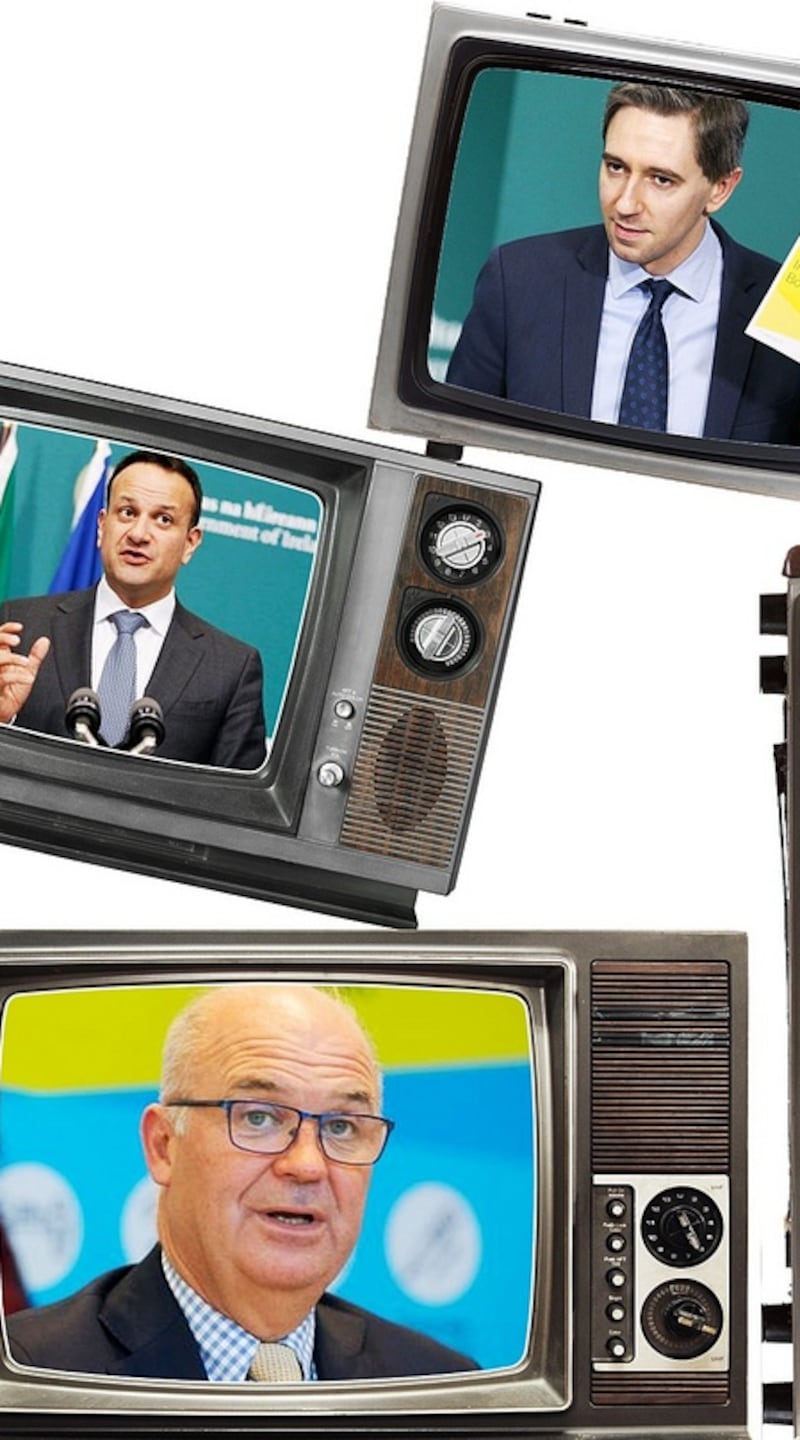March 9th, 2020
Cases: 24; Deaths: 0; Seven-day average of new cases: 5
Chief medical officer Tony Holohan projected a slide on to the wall of conference room 242 in Government Buildings. It showed the number of people who would be hospitalised with Covid-19 in a worst-case scenario.
The line shot upwards on the slide before curving – this was representative of tens of thousands of people ending up in hospital. Below this curve was a straight black line tracking right across the page. "What's the black line?" asked Simon Coveney, the tánaiste and Minister for Foreign Affairs.
“That’s the hospital capacity,” Holohan responded. “That’s 10,000 beds.”
The gap between the two was massive. "It was scary, actually, because I knew what that meant," Leo Varadkar would later recall. It was the moment the scale of the threat became real for the then taoiseach, and for many others.
The cold reality of these numbers, graphs and charts, laid out before ministers, was that in a few short weeks people would be turning up at hospitals with no space for them. They would die in the car park or, just as bad, they would die at home because the ambulance service would be so overwhelmed it would not be able to reach them in time to transport them to a hospital that probably couldn't admit them anyway. This would be northern Italy – or worse.
Varadkar is known for being analytical to a fault; almost calculating. What's undeniable is that he runs the numbers
The occasion that day in conference room 242, more commonly known as the Sycamore Room (because of the large oval sycamore table in the centre) was the first meeting of the cabinet subcommittee on Covid-19.
It was, in part, a communications setpiece designed to show the public that the new virus was being taken seriously. Television cameras and photographers had been invited into what was yet another packed indoor gathering. "There were at least 50 people in that room, around the walls and at the table," Regina Doherty, the minister for social protection who had lost her Dáil seat a month earlier, later said. "We just crowded in. It was just bizarre. It was as if we knew the seriousness of the decision we were making but not the impact that the actual virus would have on us."
For some in the room a sense had been dawning that Covid-19 was more serious than any infectious disease the State had previously grappled with. Minister for health Simon Harris and his team had been embedded in the issue for weeks. Paschal Donohoe had been hearing horror stories from his Italian counterpart, Roberto Gualtieri, at meetings of EU finance ministers. "He said what's happening on the ground in China is grave, exceptionally serious and if it's not on your radar screen, it needs to be," Donohoe later recalled.
The affable Minister for Finance had also been part of a smaller group of ministers, the taoiseach himself and senior civil servants, including the likes of Martin Fraser, the taoiseach's secretary general, and Robert Watt, the secretary general of the Department of Public Expenditure, who had seen some of the grimmest projections in relation to mortality that were based on early, rough modelling.
The memo prepared for ministers for that meeting on March 9th noted that "mathematical modellers are using data from the Covid-19 outbreaks already seen in more severely affected countries to predict what the impact in Ireland is likely to be". After the cameras left, Holohan's PowerPoint presentation focused on the evidence from China and Italy.
The disease was highly infectious and people were dying. Rough modelling indicated that as many as 20,000 people in Ireland could die. It was not sophisticated, and the message was not complicated, but it shocked most of those in the room.
People briefed on early modelling recall how it showed that up to 80 per cent of the population could be infected, and 40 to 50 per cent would have a clinical disease. Some 2 million people could be sick.
While 80 per cent of those would have relatively mild symptoms, 15-20 per cent would require hospitalisation – somewhere in the region of 400,000 people. Another 100,000 would be in high-dependency or intensive care units. It was a nightmare scenario of unprecedented proportions. “Obviously a situation where there are 2,000 deaths is entirely different from a situation where there are 20,000 deaths, and we need to avoid 20,000 deaths,” Varadkar told the meeting.
Varadkar, staffers recall, could walk past you in a corridor without acknowledgement half the time and look right through you the other half
The modelling showed clearly that closing the country would make a difference – a significant difference – in suffering and death. Suddenly this was no longer a difficult call for self-described civil libertarian Varadkar. The decisions he finds difficult in politics are the ones with many moving parts, and no obvious clear option – sometimes just an array of bad choices. Combining that with the intangible calculus of electoral politics – the trade-offs, the judgment calls, the inexactitude and the high stakes – is difficult. Even though the decision to lock down would be momentous, it wouldn’t actually be that difficult.
Varadkar is known for being analytical to a fault; almost calculating. What’s undeniable is that he runs the numbers. Hundreds of people can die from seasonal flu in a bad year, but this was not a seasonal flu.
Avoiding 20,000 deaths would likely require the imposition of public health restrictions. “We would never shut down the country, put people out of their jobs, and close the borders for the flu season. But 20,000 to 80,000 [deaths] was a whole other ball game,” Varadkar later said.
The memo given to ministers that day was blunt. Options were being narrowed as one outcome became unavoidable.
“There is currently a moderate to high risk that Covid-19 will become established in Ireland in the coming weeks in a manner similar to that seen in Italy and it is expected that Ireland will see a rapid increase in numbers of confirmed cases. If it does become established here it is likely that this will happen quickly and that most cases will occur over the following 12 weeks.”
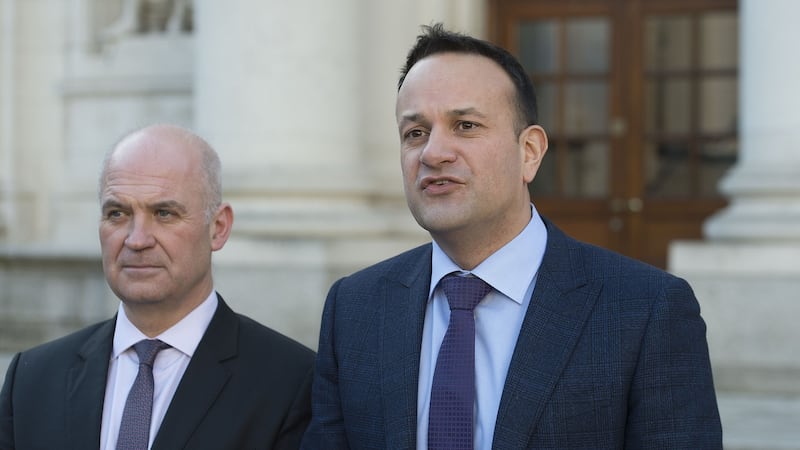
The document noted that evidence from other countries was that “Covid-19 will affect the most vulnerable in Irish society, and specifically older people and people with pre-existing medical conditions”. Covid-19 infection “places extraordinary pressure on the health system, whatever the level of the health service’s development and resources”.
The State could only slow the spread of the disease. "There's a lot about this virus that we don't know," Varadkar told the media after the meeting, ashen-faced alongside a drawn-looking Harris and the equally grave minister for business, Heather Humphreys. "But it is possible we're facing events unprecedented in modern times."
In an interview with Seán O'Rourke on RTÉ Radio 1 on March 10th, the day after the cabinet subcommittee meeting, Paschal Donohoe outlined the new stance: "Whatever resources we need to mobilise to help deal with this, the government will do."
For many in Fine Gael, it wasn't so much what Donohoe said about the gravity of the situation but the political departure he signalled that really caused ears to prick up. For weeks in the aftermath of the election Fine Gael had been resisting entering talks to form a new government.
From the taoiseach down, the leadership of the party was expecting – publicly and privately – to enter opposition. Now, Donohoe told O’Rourke, the political context “had very significantly and fundamentally changed” and could be changed for “quite a while”.
The State only had so many arrows in its quiver, and couldn't shoot them all at once
Privately, Donohoe had begun communicating this to Michael McGrath, Fianna Fáil’s finance spokesman. “I want to do this,” he would say to McGrath.
“We were facing a threat of the highest magnitude. We were going to be building morgues for people. I knew the work was under way to build those emergency facilities,” Donohoe would later say. “It wasn’t so much a potential threat – I already knew our welfare systems couldn’t deal with it – it was an existential threat.”
A meeting of ministerial advisers called by Brian Murphy, Varadkar's chief of staff, rammed the point home. Murphy, who first joined Varadkar's staff when he was minister for transport, was a veteran. Gregarious and shrewd, he was seen by colleagues as politically sharp, and possessing an emotional savviness – a human side, where his boss was notoriously weak.
He was hugely protective of the taoiseach, softening his boss’s hard edges by being likeable and pleasant to all comers. Varadkar, staffers recall, could walk past you in a corridor without acknowledgement half the time and look right through you the other half. Murphy would make the effort: “He humanises Leo’s political operation,” one colleague said. For all the friendliness, though, Murphy carried a big stick. Many of the advisers were battle-weary after years in government and bloodied by the election result; and they faced losing their jobs if their bosses had lost their seats, or if they failed to retain cabinet roles even if Fine Gael did stay in government.
The first death from Covid-19 in the State was confirmed. It was a sad and symbolic moment. However, there was still no sense of how imminent things were
At the meeting Murphy delivered a series of blunt and shocking messages: there were going to be a lot of cases, a lot of sickness; and a lot of people were going to die. Notwithstanding how tired or unmotivated people were, the message was, one participant recalled: “That you guys are paid by the Irish taxpayer, and the s**t is about to hit the fan, so everyone to your posts.” Murphy told the group that Covid was likely to be with them for between three and six months. Steps like those then being taken in Italy were going to happen, and businesses were going to close, he said, giving a bleak assessment of the outlook for the economy.
Murphy said that steps like closing schools and restricting travel would be held in reserve; they would devastate the country, and could only be done at the right time, otherwise public compliance would slip. The State only had so many arrows in its quiver, and couldn’t shoot them all at once. Some would have to be held back, he said. But a little over 24 hours later, many of these arrows would be fired.
That day, March 10th, Nphet gathered in the Department of Health for its regular Tuesday meeting. It was clear there was a step change coming – the need for improved modelling, changing the policy of hospitalising every case as numbers increased, and increasing testing were all flagged. It was also a meeting at which the first death from Covid-19 in the State was confirmed. It was a sad and symbolic moment. However, there was still no sense of how imminent things were: the meeting discussed Nphet's inputs into the State's National Action Plan, still being drafted, and agreed to sign off on them on Thursday, March 12th.
Then, everything changed.
March 11th, 2020
Leo Varadkar arrived in Washington, DC, having cancelled both the New York leg of his St Patrick's Day trip to the US and his attendance at an earlier business leaders' lunch in DC. There had been doubts about whether he would travel at all. The trip was going ahead because of concerns relayed by the Irish Ambassador in Washington, Dan Mulhall, that if it did not happen in some form, the annual tradition could be scrapped altogether.
There was another crucial reason in that neither the taoiseach nor his team wanted to give any impression that a lockdown was imminent – and spark public panic – by doing something unusual like cancelling the annual trip to the US. “If you’re not ready to do it [lockdown], you should not start doing things that look unusual,” one senior official later recalled.
The $1,000-a-plate Ireland Funds dinner in the National Building Museum is a staple of the DC Beltway circuit, and the high point of the year for Irish America, attended by the great and the good of its business and political worlds.
Mulhall, a veteran diplomat who had previously served as Irish ambassador to London and Berlin, had already decided to cancel an Irish Embassy event he was due to hold the following day. By contrast, the organisers of the Ireland Funds dinner were determined their event should go ahead, but fears over the virus had already dissuaded some guests from coming.
The 27 new cases represented a trebling of the previous day's numbers. It was enough to prompt Holohan to take action. 'We need a meeting,' he said. 'We can't sit on this'
Attendance was notably down for a mediocre dinner – an artisan charcuterie display of various meats and cheeses; a main course of pavé of beef tenderloin or smoky herb panko-crusted salmon; and a dessert buffet. Attendees were promised special entertainment. What they got was a bizarre musical interlude from a guitar-wielding former US congressman, Joe Crowley, whose career on Capitol Hill was ended by Alexandria Ocasio-Cortez in 2018.
By that stage the dinner had already been overshadowed by president Donald Trump's sudden announcement that the US would, from that Friday, suspend all travel from Europe, excluding the UK, for 30 days in response to the escalating coronavirus outbreak. At the top table, Varadkar sat with, among others, US House speaker Nancy Pelosi. A short time before the ban was made public, a member of Pelosi's staff had tapped her on the shoulder. "Speaker, you have to come out and take a call, the White House is looking for you," the aide told the veteran California congresswoman.
She left the room and returned 15 minutes later, informing some of those around the table that Trump was going to ban travel from the Schengen area. “What is the Schengen area?” she was overheard asking.
Harris told his boss that it was likely that very serious decisions would have to be taken that night
Brian Murphy's dinner had already been interrupted by Martin Fraser: "Look, I need to talk to you." But it wasn't about the travel ban. Fraser had been at another table, sitting alongside Diane Dodds, the Northern Ireland economy minister, simultaneously trying to hint to her that Covid was likely to cause major issues while not letting on about imminent restrictions in the South. As he was having his dinner his phone rang. It was Liz Canavan, one of his key lieutenants in the Department of the Taoiseach. There was news from Dublin.
A short time later Fraser came for Varadkar, whispering in the taoiseach’s ear. “We have to go,” he said urgently. Fraser wanted to extricate Varadkar from the room in a manner that would not cause a fuss, but the taoiseach’s abrupt exit prompted a flurry of tweets from Irish journalists in the cheap seats on the edge of the main hall. They assumed he had been whisked away to be briefed on the implications of the Trump travel ban. But in an empty private room at the National Building Museum, the taoiseach, along with Murphy and Fraser, was being given an update from home . . . and it was not good.
That evening in Dublin, Tony Holohan called an emergency meeting of Nphet. Virologist and Nphet member Cillian de Gascun had relayed news of a sharp increase in the number of new cases. The 27 new cases Nphet would publicly report the following day represented a trebling of the previous day’s numbers.
It was enough to prompt Holohan to take action. “We need a meeting,” he said. “We can’t sit on this.”
Simon Harris was putting his dinner in the oven at home in Greystones when Holohan rang. As he changed back into his suit, Harris rang Brian Murphy and briefed him on what was happening back home. At 8.40pm, Harris texted Varadkar with what he described as "very worrying developments" with Covid-19. An emergency meeting of Nphet had been called and there was significant community transmission and very ill patients, Harris told his boss, and it was likely that very serious decisions would have to be taken that night.
As they grappled with the news in DC, Harris contacted Simon Coveney, the most senior member of the government in Ireland that night. Coveney offered to come into the Department of Health.
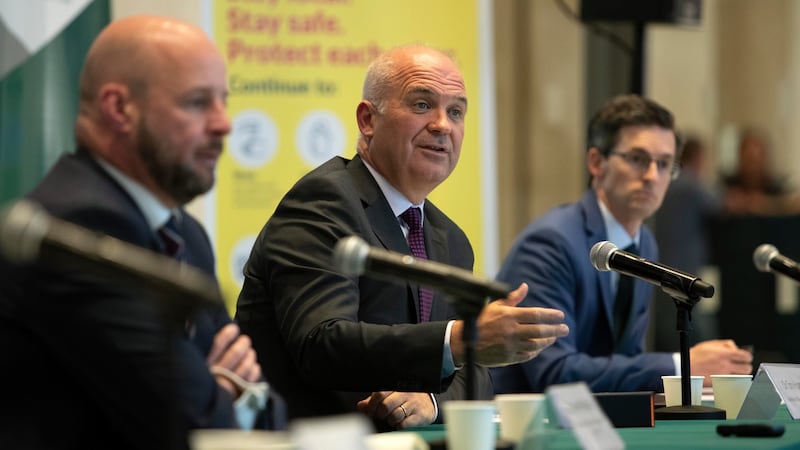
On the seventh floor of the department, the Nphet meeting ran for some three hours. The data was pored over. Sources later remembered how some of the cases were linked to an outbreak in a Dublin Airport hotel, where trainee flight attendants from Italy were staying as part of an exercise run by their airline. Was this an isolated cluster, they wondered, or was the sudden increase evidence of community transmission?
At that stage, Ireland was in the containment phase, attempting to detect early cases and tracing their contacts in a bid to limit the spread. But now the delay phase was being contemplated, in which measures like restrictions on mass gatherings would be recommended to limit the spread of the virus. It was 1am before the Nphet meeting broke up.
Holohan made his way downstairs to the sixth floor where Harris, Coveney, their advisers and department officials had been waiting for several hours. Accompanied by two Department of Health assistant secretaries, Tracey Conroy and Fergal Goodman, Holohan sat to Harris's right and opened his zipped brown leather folder.
The chief medical officer later recalled feeling a sense of “genuine trepidation” at this moment. He had been in the role for more than a decade, advising numerous ministers for health, but he had never proposed shutting down the economy. “I don’t mind admitting I was nervous, but I knew this was necessary,” he said.
He handed the minister a piece of paper with a printed list of Nphet recommendations for the government to consider and implement. Schools, colleges and childcare facilities should close, along with cultural institutions. Indoor mass gatherings of more than 100 people and outdoor gatherings of more than 500 people should be cancelled.
'We all need to go for a few pints here now,' Martin Fraser told everyone who was with him
Holohan told Harris that this needed to happen early the next day and that communication of the measures would be vital in order to avoid widespread chaos. A decision was taken not to ring minister for education Joe McHugh to tell him or his department that schools would have to shut for fear it would leak. His staff hit the roof.
The softly spoken Donegal TD had to phone the taoiseach and insist on his involvement. "Simon [Coveney] is in charge," Varadkar told him. When McHugh rang Coveney he was not asking to be part of the press conference; he was declaring that he would be there. Coveney later acknowledged McHugh's legitimate grievance but insisted there was ample reason for not briefing him in advance or inviting him to the press conference.
“The idea that a journalist could have got a scoop to say the country’s about to go into lockdown at 3am or 4am, or for Morning Ireland, without any context around that, would have really triggered potential panic,” Coveney would later recall. “The country needed the taoiseach to tell them why.”
What’s more, there were concerns in government that the Department of Education could be leaky. A false alarm over the closure of schools had already been reported in local media in recent days, and the department was suspected as being the source of the garbled messaging.
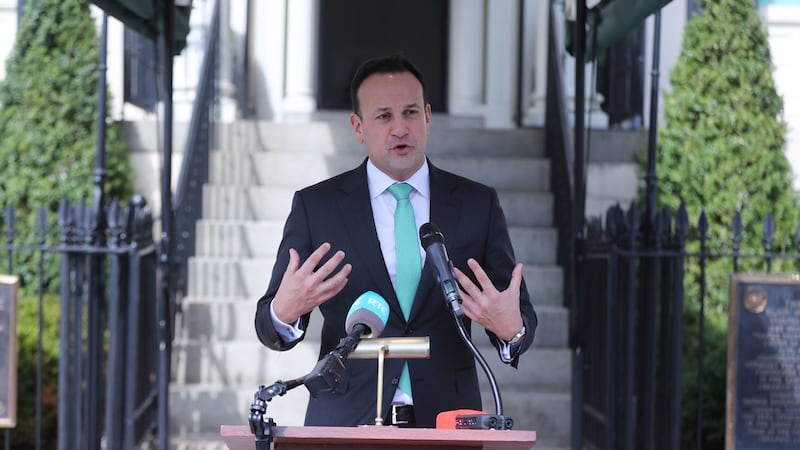
Coveney, whom Varadkar spoke to that night, later recalled that the taoiseach was “deeply frustrated that he wasn’t in Ireland”. Varadkar maintains he was not annoyed, however. “We thought this was going to happen, we knew the direction of travel in terms of the restrictions, at the time,” he later recalled.
However, the bigger problem right there and then in the National Building Museum at 10pm DC time was trying to get the taoiseach back to Blair House without arousing suspicion among the travelling Irish press corps. Fortunately, Varadkar had a secret service detail assigned to him who were skilled in the art of clandestine extractions. As their boss was quietly removed from the building, Fraser and Murphy went back down to the main function. "We all need to go for a few pints here now," Fraser told everyone who was with him. The intention was for the taoiseach's team to drink in plain sight of the fourth estate – it was vital that nothing gave the game away.
Press aide Sarah Meade calmly told the hovering Irish journalists that the taoiseach would speak to them early the next morning. It was, in the view of senior officials that night, a moment of great peril. It could have caused "an absolute catastrophe", one said. Controlling the message of imminent major restrictions was crucial to the pandemic response, and so they tried to give the impression of normality. But they drank bottles, not pints. There was important work to be done in the morning.
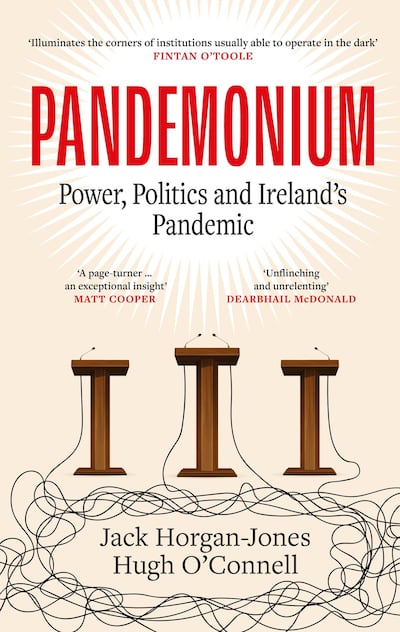
That night, the taoiseach lay in bed in his Blair House guest room tapping out a short speech on his iPhone before sending it to Meade in the small hours of Thursday morning. The taoiseach would address the Irish nation at the bottom of the steps leading up to the president’s guest house. Flagpoles had to be sourced from the Irish Embassy and brought over as dawn broke across the US capital.
Just before 7.30am DC time, Fraser, Murphy and the rest of the taoiseach’s delegation emerged from Blair House and walked down the steps. The grave looks on their faces said it all. “Pay attention,” Fraser told a waiting journalist, pointing to the podium where Leo Varadkar arrived moments later.
“I need to speak to you about coronavirus and Covid-19,” the taoiseach began.
Jack Horgan-Jones is a political reporter at The Irish Times. Hugh O’Connell is a political correspondent with the Sunday Independent and Irish Independent. Pandemonium: Power, Politics and Ireland’s Pandemic is published by Gill
